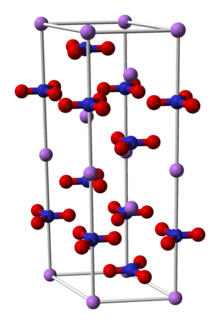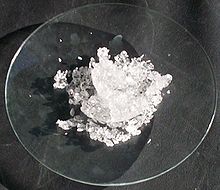Lithium nitrate

| |
 | |

| |
| Identifiers | |
|---|---|
3D model (JSmol)
|
|
| ChemSpider | |
| ECHA InfoCard | 100.029.290 |
PubChem CID
|
|
| RTECS number |
|
| UNII | |
CompTox Dashboard (EPA)
|
|
| |
| |
| Properties | |
| LiNO3 | |
| Molar mass | 68.946 g/mol |
| Appearance | White to light yellow solid |
| Density | 2.38 g/cm3 |
| Melting point | 255 °C (491 °F; 528 K) |
| Boiling point | 600 °C (1,112 °F; 873 K) (decomposes) |
| 52.2 g/100 mL (20 °C) 90 g/100 mL (28 °C) 234 g/100 mL (100 °C) | |
| Solubility | soluble in ethanol, methanol, pyridine, ammonia, acetone |
| −62.0·10−6 cm3/mol (+3 H2O) | |
Refractive index (nD)
|
1.735[1] |
| Thermochemistry | |
Heat capacity (C)
|
64 J/mol K |
Std molar
entropy (S⦵298) |
105 J/mol K |
Std enthalpy of
formation (ΔfH⦵298) |
-7.007 kJ/g or -482.3 kJ/mol |
Gibbs free energy (ΔfG⦵)
|
-389.5 kJ/mol |
Std enthalpy of
combustion (ΔcH⦵298) |
25.5 kJ/mol |
| Hazards | |
| Occupational safety and health (OHS/OSH): | |
Main hazards
|
Oxidant, irritant |
| NFPA 704 (fire diamond) | |
| Flash point | Non-flammable |
| Lethal dose or concentration (LD, LC): | |
LD50 (median dose)
|
1426 mg/kg (oral, rat) |
| Related compounds | |
Other cations
|
Sodium nitrate Potassium nitrate Rubidium nitrate Caesium nitrate |
Related compounds
|
Lithium sulfate Lithium chloride |
Except where otherwise noted, data are given for materials in their standard state (at 25 °C [77 °F], 100 kPa).
| |
Lithium nitrate is an inorganic compound with the formula LiNO3. It is the lithium salt of nitric acid (an alkali metal nitrate). The salt is deliquescent, absorbing water to form the hydrated form, lithium nitrate trihydrate. Its eutectics are of interest for heat transfer fluids.[2]
It is made by treating lithium carbonate or lithium hydroxide with nitric acid.
Uses
This deliquescent colourless salt is an oxidizing agent used in the manufacture of red-colored fireworks and flares.
Thermal Storage
The hydrated form, lithium nitrate trihydrate, has an extremely high specific heat of fusion, 287 (± 7) J/g,[3] and hence can be used for thermal energy storage at its melt temperature of 303.3 K.[4]
Lithium Nitrate has been proposed as a medium to store heat collected from the sun for cooking. A Fresnel lens would be used to melt solid lithium nitrate, which would then function as a 'solar battery', allowing heat to be redistributed later by convection.[5]
Synthesis
Lithium nitrate can be synthesized by reacting nitric acid and lithium carbonate.
- Li2CO3 + 2 HNO3 → 2 LiNO3 + H2O + CO2
Generally when forming LiNO3, a pH indicator is used to determine when all of the acid has been neutralized. However, this neutralization can also be recognized with the loss of carbon dioxide production.[6] In order to rid the final product of excess water, the sample is heated.
Toxicity
Lithium nitrate can be toxic to the body when ingested by targeting the central nervous system, thyroids, kidneys, and cardio-vascular system.[7] When exposed to the skin, eyes, and mucous membranes, lithium nitrate can cause irritation to these areas.[8]
Further reading
- Berchiesi, Gianfrancesco; Vitali, Giovanni; Amico, Antonio (1985). "Transport properties of lithium nitrate and calcium nitrate binary solutions in molten acetamide". Journal of Chemical & Engineering Data. 30 (2): 208–9. doi:10.1021/je00040a023.
- Kelly, Michael T; Tuan, Christopher Y (2006). "A Case Study Evaluating the Use of Lithium Nitrate to Arrest Alkali-Silica Reaction in an Existing Concrete Pavement". Airfield and Highway Pavement. pp. 625–35. doi:10.1061/40838(191)53. ISBN 978-0-7844-0838-4.
- Muniz-Miranda, Francesco; Pagliai, Marco; Cardini, Gianni; Righini, Roberto (2012). "Bifurcated Hydrogen Bond in Lithium Nitrate Trihydrate Probed by ab Initio Molecular Dynamics". The Journal of Physical Chemistry A. 116 (9): 2147–53. Bibcode:2012JPCA..116.2147M. doi:10.1021/jp2120115. PMID 22309150.
- Ruiz, María L; Lick, Ileana D; Leguizamón Aparicio, María S; Ponzi, Marta I; Rodriguez-Castellón, Enrique; Ponzi, Esther N (2012). "NO Influence on Catalytic Soot Combustion: Lithium Nitrate and Gold Catalysts". Industrial & Engineering Chemistry Research. 51 (3): 1150–7. doi:10.1021/ie201295s.
References
- ^ Pradyot Patnaik. Handbook of Inorganic Chemicals. McGraw-Hill, 2002, ISBN 0-07-049439-8.[page needed]
- ^ Wietelmann, Ulrich and Bauer, Richard J. (2005) "Lithium and Lithium Compounds" in Ullmann's Encyclopedia of Industrial Chemistry, Wiley-VCH: Weinheim. doi:10.1002/14356007.a15_393.
- ^ Shamberger, Patrick J; Reid, Timothy (2012). "Thermophysical Properties of Lithium Nitrate Trihydrate from (253 to 353) K". Journal of Chemical & Engineering Data. 57 (5): 1404–11. doi:10.1021/je3000469.
- ^ Kenisarin, Murat; Mahkamov, Khamid (2016). "Salt hydrates as latent heat storage materials:Thermophysical properties and costs". Solar Energy Materials and Solar Cells. 145 (3): 255–86. doi:10.1016/j.solmat.2015.10.029.
- ^ http://barbequelovers.com/grills/a-solar-grill-prototype-for-a-greener-tomorrow[full citation needed]
- ^ "Synthesis database: Lithium nitrate synthesis". Amateur Science Network. Retrieved 18 June 2012.
- ^ "Material Safety Data Sheet". Sigma-Aldrich Catalog. Retrieved April 12, 2012.
- ^ "Chemical Datasheet". CAMEO Chemicals. Retrieved April 26, 2012.

